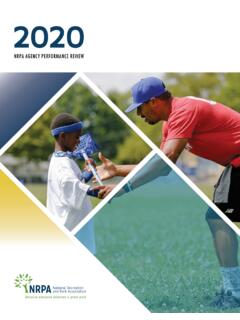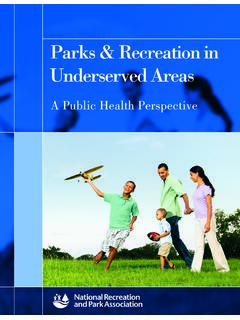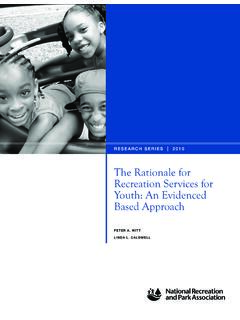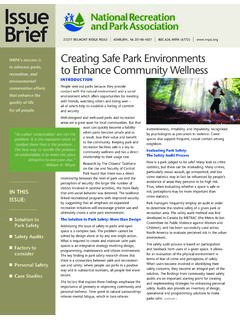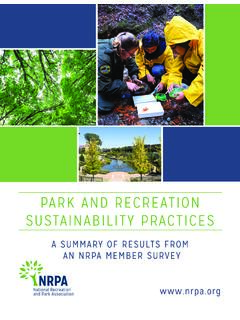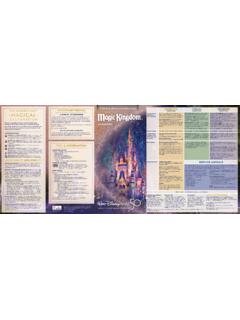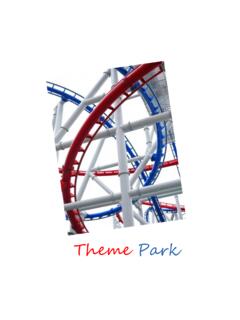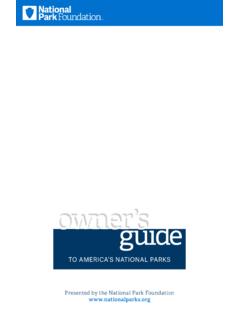Transcription of Pocket Parks - Parks and Recreation, Park and Rec
1 INTRODUCTION Providing quality park and recreation space for inner city residents is increasingly challenged by the limited amount of available park space in urban areas. As a result of the diminishing access to Parks and open spaces, the physical and recreational needs of urban youth often go unmet. To meet these growing needs, park and recreation agencies are in a position to play an important role in the conversion of unused areas and abandoned spaces into what are being called mini or Pocket unique Parks are often created out of vacant lots, rooftops and otherwise forgotten and unused spaces. WHAT IS A Pocket park ?A Pocket park is a small outdoor space, usually no more than of an acre, usually only a few house lots in size or smaller, most often located in an urban area surrounded by commercial buildings or houses on small lots with few places for people to gather, relax, or to enjoy the outdoors. They are also called vest Pocket Parks , a term first used in the 1960 s.
2 Pocket Parks are urban open spaces on a small-scale and provide a safe and inviting environment for surrounding community members. They also meet a variety of needs and functions, including: small event space, play areas for children, spaces for relaxing or meeting friends, taking lunch breaks, etc. Successful Pocket Parks have four key qualities: they are accessible; allow people to engage in activities; are comfortable spaces and have a good image; and finally, are sociable places: one where people meet each other and take people to when they come to visit. BENEFITS OF Pocket Parks It is important to note that Pocket Parks are not intended to service an entire city in the same way as a neighborhood or city park . Each should be created with the specific interests and needs of the contiguous community that is, the nearby individuals and families for whose use it was originally intended (Olmos, 2008). continued >Creating Mini- Parks for Increased Physical ActivityNRPA s mission is to advance Parks , recreation, and environmental conservation efforts that enhance the quality of life for all people.
3 _____IN THIS ISSUE:_____n What is a Pocket park ?n Benefitsn Fundingn Step-By-Step Plansn Case Studiesn Resources IndexIssue Brief22377 BELMONT RIDGE ROAD | ASHBURN, VA 20148-4501 | (6772) | MECHANISMS Many Pocket Parks have been created as a result of community groups organizing and rallying for more open space within the urban environment. Leftover spaces and other urban eyesores present opportunities for conversion to Pocket Parks , offering important and desirable amenities to communities. These are often purchased and owned by cities, with the agreement that they will be run and maintained by a foundation or other organization if the city is unable to maintain the park itself. The benefits of these unique urban spaces often include one or several of the following:n Support the overall ecology of the surrounding environmentn Help protect and conserve local wildlife, landscape, and heritagen Reduce pollution, traffic, and consumption of resources, such as oiln Empower local residents to make decisions that affect their communityn Make communities safer and more sociablen Improve fitness and healthn Regenerate run-down areasn Reinforce relationships between local authorities and communities Though Pocket Parks vary according to specific purposes and locations, there are numerous characteristics that the majority has in common.
4 For example:n Pocket park users should not have to walk more than 5 to 10 minutes to reach their destination. n Since parking may or may not be provided, the Parks should be accessible by both foot and bike, and should not require the use of a car. n Parks should serve a resident population of approximately 500-1000 persons. n Parks should strive to accommodate as many different users as possible, prioritizing the needs of surrounding gardens are a popular choice when creating a Pocket park that is being designed for neighborhood interaction by people of all ages. Unlike playscapes, they typically do not include play structures; instead they provide the land, resources, and informational support necessary to grow food for local sale and consumption. Community gardens have a variety of purposes for the people they serve; they unite residents of all ages in fun and productive outdoor activities and facilitate the growth of community solidarity and neighborhood Pocket Parks There are many possible funding sources for the development of Pocket Parks .
5 The Trust for Public Land is one organization that offers assistance with private and public funding for mini- Parks (Trust for Public Land, 2009). At the local level, public-private ventures, individual contributions, and philanthropic support are often solicited to underwrite start-up and equipment some Parks are financed almost entirely with private funds, many are typically financed by a combination of various funding sources. For example, capital support for the acquisition, design, and development of the 6th Avenue NW Pocket park in Seattle, Washington consisted of joint contributions from the Pro Parks Levy, the Neighborhood Matching Fund, and the local community. These organizations continue to contribute towards enhancement of Parks including: large lawn areas, landscaping, paths, neighborhood gathering areas and interactive features for children s play. CREATING A Pocket park In organizing Pocket Parks , designers must often work out a delicate balancing act so that all groups can use the space in peaceful co-existence.
6 There are no set designs for Pocket Parks ; each one is different depending on the size and use of the space, but because space is restricted and user needs are both diverse and vary throughout the day, conflicts can sometimes arise between different groups. Thus, park and recreation agencies can fulfill the community s vision for the Parks by assisting in the development of an implementation strategy, beginning with small-scale, doable improvements that can immediately bring benefits to public spaces and the people who use them. More importantly, park and recreation agencies can help design Parks to provide the maximum benefit to the community. Since mini- Parks cannot provide all the benefits of large Parks , park and recreation agencies can help identify what trade-offs may be necessary. As with any new park or recreation innovation, there are challenges in the development of Pocket Parks . Some of the more commonplace examples of issues typically faced in the development of Pocket Parks include: n Limited money and staff timen Insufficient Pocket Parks to meet high demandn Insufficient support for training and networking n Too few volunteers2 STEP-BY-STEP PLAN FOR CREATING A Pocket park The following steps can help your neighborhood get started in creating a beautiful oasis of green for all to enjoy!
7 1. Secure the community s commitment. The more inclusive the decision-making, the more successful the park will be. Start talking to as many neighbors as possible and secure them to help you throughout the process. Think about those in your neighborhood. Is there someone who is an expert gardener, someone who knows what s going on at every block or someone that can let you use their spigot for water? Seek these people out and get them involved. 2. Convene a steering committee. You will need local leadership for the project. One of the best ways to accomplish this is to create a committee with divided responsibilities in terms of planning and working on the project. 3. Choose a site. Think about how the site will be used. What kinds of improvements are needed? Keep in mind how much the neighborhood can realistically take on to address issues such as the creation and maintenance of the plan and make sure the space suits all expectations. 4. Plan. Determine a site plan either with the help of a landscape architect.
8 Begin to strategize how the landscaping will be installed, how it will be funded, and how the neighborhood will maintain it in the long run. 5. Identify and secure potential partners. Partners should be local businesses, nonprofits and other organizations available in the city. Identify the roles of each partner and secure a written understanding if Secure long-term and short-term funding. Begin to look at various resources for funding in the form of grants, in-kind materials and money from businesses. Consider corporate sponsorships and be sure to think long-term about funding and saving money for maintenance and repairs in the future or to cover other necessary items including liability insurance coverage. 7. Schedule work days in advance. Assign a project manager and plan out what activities need to occur in what order. Can everything be done in one day, or will it take multiple work days? 8. Plan a big work day/dedication/celebration event. This is a very important part of the process to the neighborhood and to the partners.
9 This is a chance to possibly garner media attention, as well as involve as many people as possible. 9. Implement a maintenance plan. Before any plants go in the ground, the neighborhood should agree to a maintenance plan and document it in Pursue consistent engagement. Just as maintenance is a never-ending job, so is everything else involved. On-going communication with the neighborhood especially should keep them interested and involved in your project. continued Page 4 > ROTARY CENTENNIAL PARK_____Location: Long Beach, CaliforniaDescription: Rotary Centennial park , a new Mini park is located on the corner of Pacific Coast Highway and Junipero Street. The park was first constructed when the Rotary Club approached the department with the idea of collaborating on the construction of the new park in celebration of the100th anniversary of Rotary International in : Develop a viable plan converting the city-owned undeveloped land along the former Pacific Electric right-of-way that is surrounded by a densely developed area with nearly 80 percent of the residents living in apartments with no : To celebrate the 100th anniversary of Rotary International in 2005, the Long Beach Rotary Club raised $100,000 to help design and construct a park at Pacific Coast Highway and Junipero Avenue.
10 Long Beach Rotary involved the public and stakeholders throughout the design process. Community input was translated into plans that incorporated a solar system theme with art installations of planets, a sundial sculpture, benches, turf, trees, playground equipment, and a shade shelter. These creative elements have made Rotary Centennial park one of the most unique and inviting Parks in the city and a welcome addition to a park -poor neighborhood. Custom engraved Community Bricks were sold at $50 and $100 each. The additional funds went to help pay for educational public art. The park was dedicated on May 21, 2005 on Rotary International s 100th Learned: Continuing support from the park s partner became a critical aspect of the project continuing success. The Rotary s involvement didn t stop with the park s creation and every month since the park opening, Long Beach Rotarians have held work parties to help clean, repair and maintain the park . THE FARM-A-LOT PROGRAM_____Location: Detroit, MichiganDescription: Detroit has more than 28,000 vacant parcels owned by the city almost half of them residential plots that generate no significant tax revenue and cost more to maintain than the city can afford.

